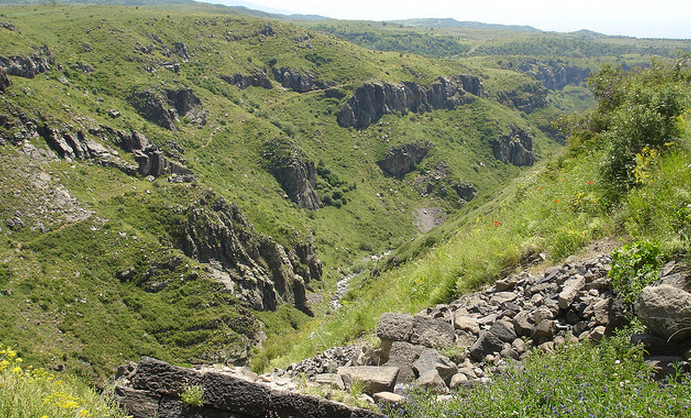Capacity Building for Optimization of Information and Monitoring System in Armenia
Project Overview
The project will strengthen Armenia's capacity for environmental information management in order to improve the reporting process to the Conventions, as well as to ensure national sustainable development through improved monitoring and information management for better environmental policy development. Environmental monitoring and information management is critical for understanding the current status and dynamic changes in the state of environment. Consistent and regular monitoring, research and data analysis provide the essential foundation for adequate policy response and timely and appropriate national decision-making process. Hence, the issue has both global and national priority dimensions.
Project Details
Armenia is a small, land locked and alpine country with a complex relief structure (29,800 km2 and 3.2 million people) located in the region of Transcaucasia. It is ranked 83 in the 2005 Human Development Report with an HDI value of 0.759, and has a GDP of US$5,100 (2005 est.) per capita (111th in the world).
The main current environmental issues as soil pollution from toxic chemicals such as DDT; the energy crisis of the 1990s led to deforestation when citizens scavenged for firewood; pollution of the Hrazdan (Razdan) and Aras Rivers; the draining of Sevana Lich (Lake Sevan), a result of its use as a source for hydropower, threatens drinking water supplies and the restart of Metsamor nuclear power plant in spite of its location in a seismically active zone.
This project will strengthen the national capacity for environmental information management in the country in order to improve the reporting process to the Conventions, as well as to ensure national sustainable development through improved monitoring and information management for better environmental policy development. Environmental monitoring and information management is critical for understanding the current status and dynamic changes in the state of environment. Consistent and regular monitoring, research and data analysis provide the essential foundation for adequate policy response and timely and appropriate national decision-making process. Hence, the issue has both global and national priority dimensions.
As outlined in Armenia's Initial National Commmunication (1998) climate change will cause significant negative consequences for the nature of Armenia. Thus, the application of measures and approaches, directed to the maximum reduction of these consequences and cease of the environmental degradation processes should become the important component of the strategy in responding to climate change.
Basic adaptation measures for the natural ecosystems of Armenia are the following:
- Creation of optimal landscape-zone structure for the republic as a whole (increase of the forest share given the preservation of landscape diversity);
- Gradual increase of forest cover area for 266500 ha by the year 2050, i.e. from present 11.2 % of territory up to 20.1 % through annual forest planting, including the area of protective woodland belt for 5300ha; making of a large-scale timber industry plantations of accelerated rotation; application of integrated system of forest protection from pests, illnesses, weeds, cuttings, cattle pasture, fires, etc.
- Allocation of reserves and specially protected natural territories for the mitigation of general anthropogenic pressure on vulnerable ecosystems, including intrazonal coastal cenoses of desert and semi-desert zones, and also the Alpine communities for the realization of their own adaptability at forecasted climate change;
- Introduction of endangered species, which are in proper (similar) biocenoses, which will be preserved in case of the probable climate change;
- Preservation of genetic fund of the most vulnerable and valuable species by their maintenance and cultivation in artificial conditions, preservation of genetic material in seed banks, etc.
In general, Armenia is distinguished by aridity - the average annual precipitation here reaches 570 mm. The significant part of the territory - over the 60% - receives less than 600 mm, 20 % - less 400mm, and on the bottom of the closed basins - only 200-300mm.
Armenia lays in the same geographic breadth as Spain, Italy and Greece, that is in a subtropical zone. Therefore one of the most characteristic features of its climate is intensity and abundance of solar radiation, which, accordingly, make 1.46 cal/cm2 and 2500 hours per year. This suggests the country can benefit substantially from solar power.
Armenia is amongst the first countries of the region that embarked on a National Capacity Self Assessment (NCSA) process for global environmental management. The NCSA project, funded by UNDP-GEF, provided resources to the government of Armenia to identify and determine the nature of critical capacity constraints and priority capacity needs faced by Armenia, as they relate to global environmental management. The main issues identified during this comprehensive and fully country-driven self-assessment are problems with the current information management system, which includes data collection, maintenance, analysis, information exchange and information accessibility.
The quality and accessibility of relevant data and information on the current state of the environment as well as the information management responsibilities delegated to the national institutions are the priority issues; capacity gaps exist at all levels: individual, institutional and systemic. This MSP will address theses priority issues by strengthening the monitoring and the information management capacities in Armenia, in order to improve the national environmental information and monitoring system related to the implementation of the 3 Rio Conventions.
The NCSA project has been closely linked with relevant on-going activities such as the Poverty Reduction Strategy Paper (PRSP) discussions and the initiation steps of its implementation in Armenia, the identification of the Millennium Development Goals and their indicators, the process of Environment for Europe, the development of a national policy on sustainable development and the elaboration of the UN Development Assistance Framework (UNDAF) and the UNDP Country Programme Document (CPD). The capacity assessments were conducted within the context of these activities to ensure that the project would be fully responsive to the national context and priorities, and to add value to these other processes.
Key Results and Outputs
Primary Objective: To introduce a national integrated and coordinated environmental information management and monitoring system in order to strengthen the environmental information availability and the national environmental reporting capacity of Armenia to fulfil its obligations under the 3 Rio Conventions.
- Outcome 1: The legal and regulatory framework is strengthened to enable a coordinated multi-agency information management and monitoring system.
- Output 1.1: The Laws and Codes contain the proper legislation which will provide the necessary provisions to strengthen the existing environmental information management and monitoring system.
- Output 1.2: The legislation details the appropriate institutional framework.
- Outcome 2: The institutional framework capacity is strengthened to enable a coordinated multi-agency information management and monitoring system.
- Output 2.1: An environmental monitoring coordination body is established under the MNP.
- Output 2.2: The relevant institutions for a coordinated multi-agency information management and monitoring system have the necessary capacity to fulfil their mandate.
- Output 2.3: Training curricula for environmental information management and monitoring system developed and integrated into the in-service training system for civil servants.
- Outcome 3: Environmental information management and monitoring standards, norms, procedures and IT architectures are upgraded and respond to current national and international environmental information and monitoring needs.
- Output 3.1: Standards, norms, procedures and architectures are developed to support the implementation of an effective environmental information management and monitoring system.
Reports and Publications
Assessments and Background Documents
Capacity Building for Optimization of Information and Monitoring System in Armenia - Project Document (December 2007)
Monitoring and Evaluation
The project will be monitored and evaluated in accordance with established UNDP/GEF procedures and will be conducted by the project team and the UNDP Country Office with support from UNDP-GEF. The project management reports will be presented to the Project Steering Committee (PSC) for endorsement and be distributed to the UNDP-GEF and MNP. A list of performance indicators (and their relevant targets) to measure project progress were identified. The project will use a capacity development monitoring and evaluation scorecard to monitor the project capacity development progress. It will monitor the relevant seven capacity development indicators for this project, which are of direct relevance to the improved information and monitoring system for global environmental management in Armenia (see table below). Using the baseline data collected during the PDF-A, this scorecard will be used to review/rate the relevant capacity development indicators at inception, at mid-point of project implementation and finally at the end of project implementation. This capacity development monitoring tools will be used by the project implementation team to monitor the project capacity development progress and also by the evaluators to conduct the MTE and the final evaluation.







